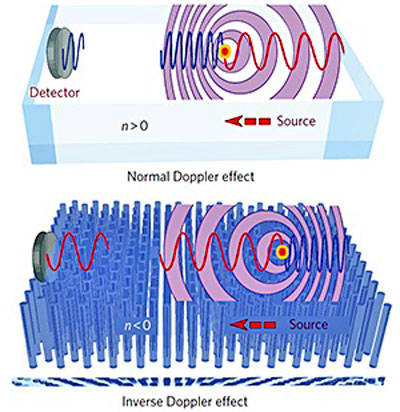|
from NatureAsia Website
In the normal Doppler effect (top), a wave appears compressed as it moves towards an observer.
In the inverse
Doppler effect (bottom), the wave appears stretched as it moves
toward the observer. The Doppler effect is common in everyday life - the sound of a motor car has a higher frequency as it approaches quickly than when it passes and moves away.
Researchers from the University of
Shanghai for Science and Technology in China, along with colleagues
from Jiangxi Normal University in China and the Swinburne University
of Technology in Australia, have now developed an experimental
technique that for the first time at optical wavelengths has allowed
them to observe the inverse Doppler effect, where an approaching
optical wave is shifted to lower frequencies1.
Scientists use this phenomenon to
determine the relative motion of stars, for example, or even
airplanes.
There are natural materials in which the
intensity variation moves slower than the particles in it, but
materials in which they move in opposite directions do not exist in
nature and can only be realized using artificial structures. So far,
scientists have been unable to verify the inverse Doppler effect in
the optical region because of the difficulty in measuring both
frequency changes and sign (peak or valley) at the same time.
The photonic crystal was mounted on a platform that moved toward the detector at a constant speed, and the Doppler shifts were measured from the interference pattern of the beams at the detector, which led to the first clear verification of the inverse Doppler effect at optical wavelengths.
In future, such experiments could be used to study other unusual Doppler effects in artificial materials.
Reference
|

